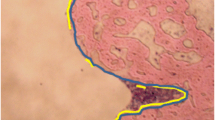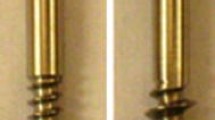Abstract
Previous studies show that surface immobilized bisphosphonates improve the fixation of stainless steel screws in rat tibia after 2–8 weeks of implantation. We report here about the immobilization of a potent bisphosphonate, zoledronate, to crosslinked fibrinogen by the use of another technique, i.e. ethyl-dimethyl-aminopropylcarbodiimide (EDC)/imidazole immobilization. Bone fixation of zoledronate-coated screws was compared to screws coated with crosslinked fibrinogen only and ditto with EDC/N-hydroxy-succinimide immobilized pamidronate. Fixation in rat tibia was evaluated by a pull-out test at either 2 or 6 weeks after implantation. Both bisphosphonate coatings increased the pull-out force at both time points, and zoledronate showed a significantly higher pull-out force than pamidronate. To further evaluate the new coating technique we also performed a morphometric study, focusing on the area surrounding the implant. The zoledronate coating resulted in an increased bone density around the screws compared to controls. No pronounced increase was seen around the pamidronate coated screws. Together, the results demonstrate the possibility of obtaining a significant local therapeutic effect with minute amounts of surface immobilized zoledronate.







Similar content being viewed by others
References
Karrholm J, Borssen B, Lowenhielm G, Snorrason F. Does early micromotion of femoral stem prostheses matter? 4–7-year stereoradiographic follow-up of 84 cemented prostheses. J Bone Joint Surg. 1994;76(6):912–7.
Mjoberg B. The theory of early loosening of hip prostheses. Orthopedics. 1997;20(12):1169–75.
Ryd L. Roentgen stereophotogrammetric analysis of prosthetic fixation in the hip and knee joint. Clin Orthop Relat Res. 1992;276:56–65.
Esposito M, Hirsch JM, Lekholm U. Thomsen P. Biological factors contributing to failures of osseointegrated oral implants. (I). Success criteria and epidemiology. Eur J Oral Sci. 1998;106(1):527–51.
Ross JR, Saunders Y, Edmonds PM, Patel S, Wonderling D, Normand C, et al. A systematic review of the role of bisphosphonates in metastatic disease. Health Technol Assess (Winchester, England). 2004;8(4):1–176.
Reid IR, Miller P, Lyles K, Fraser W, Brown JP, Saidi Y, et al. Comparison of a single infusion of zoledronic acid with risedronate for Paget’s disease. N Engl J Med. 2005;353(9):898–908.
Frith JC, Monkkonen J, Blackburn GM, Russell RG, Rogers MJ. Clodronate and liposome-encapsulated clodronate are metabolized to a toxic ATP analog, adenosine 5′-(beta, gamma-dichloromethylene) triphosphate, by mammalian cells in vitro. J Bone Miner Res. 1997;12(9):1358–67.
van Beek ER, Cohen LH, Leroy IM, Ebetino FH, Lowik CW, Papapoulos SE. Differentiating the mechanisms of antiresorptive action of nitrogen containing bisphosphonates. Bone. 2003;33(5):805–11.
Russell RG, Watts NB, Ebetino FH, Rogers MJ. Mechanisms of action of bisphosphonates: similarities and differences and their potential influence on clinical efficacy. Osteoporos Int. 2008;19(6):733–59.
Pan B, To LB, Farrugia AN, Findlay DM, Green J, Gronthos S, et al. The nitrogen-containing bisphosphonate, zoledronic acid, increases mineralisation of human bone-derived cells in vitro. Bone. 2004;34(1):112–23.
von Knoch F, Jaquiery C, Kowalsky M, Schaeren S, Alabre C, Martin I, et al. Effects of bisphosphonates on proliferation and osteoblast differentiation of human bone marrow stromal cells. Biomaterials. 2005;26(34):6941–9.
Orriss IR, Key ML, Colston KW, Arnett TR. Inhibition of osteoblast function in vitro by aminobisphosphonates. J Cell Biochem. 2009;106(1):109–18.
Nancollas GH, Tang R, Phipps RJ, Henneman Z, Gulde S, Wu W, et al. Novel insights into actions of bisphosphonates on bone: differences in interactions with hydroxyapatite. Bone. 2006;38(5):617–27.
Kajiwara H, Yamaza T, Yoshinari M, Goto T, Iyama S, Atsuta I, et al. The bisphosphonate pamidronate on the surface of titanium stimulates bone formation around tibial implants in rats. Biomaterials. 2005;26(6):581–7.
Peter B, Pioletti DP, Laib S, Bujoli B, Pilet P, Janvier P, et al. Calcium phosphate drug delivery system: influence of local zoledronate release on bone implant osteointegration. Bone. 2005;36(1):52–60.
Yoshinari M, Oda Y, Inoue T, Matsuzaka K, Shimono M. Bone response to calcium phosphate-coated and bisphosphonate-immobilized titanium implants. Biomaterials. 2002;23(14):2879–85.
Tengvall P, Skoglund B, Askendal A, Aspenberg P. Surface immobilized bisphosphonate improves stainless-steel screw fixation in rats. Biomaterials. 2004;25(11):2133–8.
Tanzer M, Karabasz D, Krygier JJ, Cohen R, Bobyn JD. The Otto Aufranc Award: bone augmentation around and within porous implants by local bisphosphonate elution. Clin Orthop Relat Res. 2005;441:30–9.
Greiner SH, Wildemann B, Back DA, Alidoust M, Schwabe P, Haas NP, et al. Local application of zoledronic acid incorporated in a poly(D, L-lactide)-coated implant accelerates fracture healing in rats. Acta Orthop. 2008;79(5):717–25.
Hilding M, Aspenberg P. Local peroperative treatment with a bisphosphonate improves the fixation of total knee prostheses: a randomized, double-blind radiostereometric study of 50 patients. Acta Orthop. 2007;78(6):795–9.
Wermelin K, Tengvall P, Aspenberg P. Surface-bound bisphosphonates enhance screw fixation in rats—increasing effect up to 8 weeks after insertion. Acta Orthop. 2007;78(3):385–92.
Dunford JE, Thompson K, Coxon FP, Luckman SP, Hahn FM, Poulter CD, et al. Structure-activity relationships for inhibition of farnesyl diphosphate synthase in vitro and inhibition of bone resorption in vivo by nitrogen-containing bisphosphonates. J Pharmacol Exp Ther. 2001;296(2):235–42.
Amanat N, McDonald M, Godfrey C, Bilston L, Little D. Optimal timing of a single dose of zoledronic acid to increase strength in rat fracture repair. J Bone Miner Res. 2007;22(6):867–76.
Bobyn JD, Hacking SA, Krygier JJ, Harvey EJ, Little DG, Tanzer M. Zoledronic acid causes enhancement of bone growth into porous implants. J Bone Joint Surg. 2005;87(3):416–20.
Gao Y, Zou S, Liu X, Bao C, Hu J. The effect of surface immobilized bisphosphonates on the fixation of hydroxyapatite-coated titanium implants in ovariectomized rats. Biomaterials. 2009;30(9):1790–6.
Skoglund B, Holmertz J, Aspenberg P. Systemic and local ibandronate enhance screw fixation. J Orthop Res. 2004;22(5):1108–13.
Wermelin K, Suska F, Tengvall P, Thomsen P, Aspenberg P. Stainless steel screws coated with bisphosphonates gave stronger fixation and more surrounding bone. Histomorphometry in rats. Bone. 2008;42(2):365–71.
Hermanson GT. Bioconjugate techniques. San Diego: Academic Press; 1996.
McCrackin F. A FORTRAN program for the analysis of ellipsometer measurements.NBS Technical Note 479, Washington DC; 1969.
Defeijter JA, Benjamins J, Veer FA. Ellipsometry as a tool to study adsorption behavior of synthetic and biopolymers at air-water-interface. Biopolymers. 1978;17(7):1759–72.
Benesch J, Askendal A, Tengvall P. Quantification of adsorbed human serum albumin at solid interfaces: a comparison between radioimmunoassay (RIA) and simple null ellipsometry. Colloids Surf B. 2000;18(2):71–81.
Aronsson H. Local delivery of bisphosphonates from FibMat Matrix [Thesis]. Linköping University, Linköping, Sweden 2008.
Wermelin K, Aspenberg P, Linderback P, Tengvall P. Bisphosphonate coating on titanium screws increases mechanical fixation in rat tibia after two weeks. J Biomed Mater Res. 2008;86(1):220–7.
Acknowledgments
This study was supported by the local strategic research project Materials in Medicine, funded by County Council of Östergötland and Linköpings Universitet, Sweden, The Swedish Research Council 2006-5647, Swedish Research Council (VR) and Trygg-Hansa Research foundation.
Author information
Authors and Affiliations
Corresponding author
Additional information
Per Aspenberg and Pentti Tengvall have shares in a company with research related to the subject.
Rights and permissions
About this article
Cite this article
Andersson, T., Agholme, F., Aspenberg, P. et al. Surface immobilized zoledronate improves screw fixation in rat bone: A new method for the coating of metal implants. J Mater Sci: Mater Med 21, 3029–3037 (2010). https://doi.org/10.1007/s10856-010-4154-x
Received:
Accepted:
Published:
Issue Date:
DOI: https://doi.org/10.1007/s10856-010-4154-x




